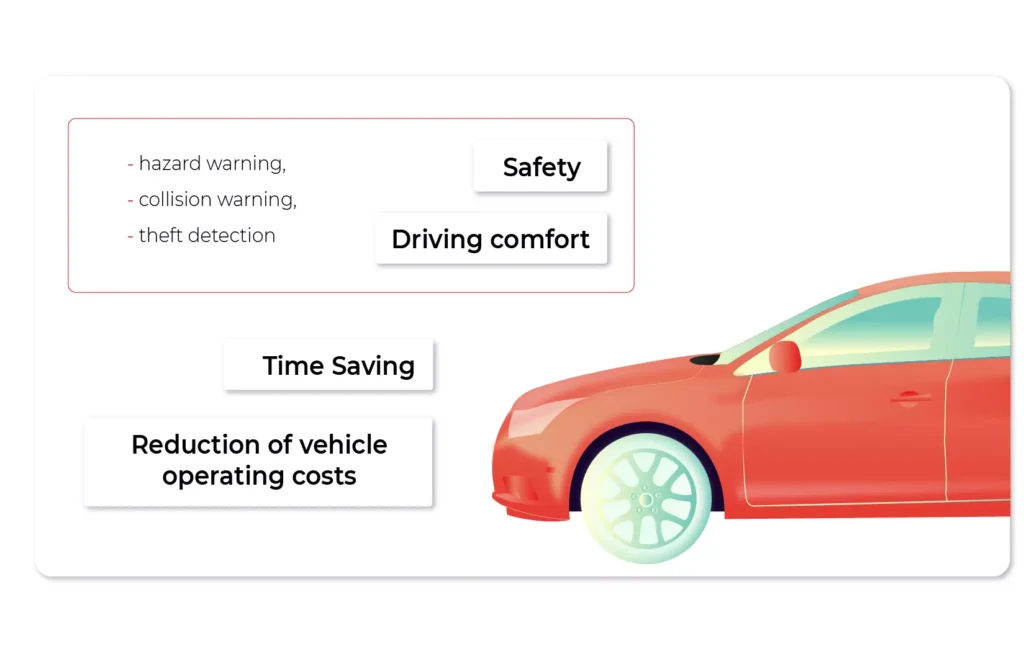Focus On the Driver – Data Monetization at Software-Defined Vehicle Cannot Exist Without Understanding Customer Needs

When talking about data monetization in the automotive industry, we tend to focus on technology, safety, sensors, or cloud solutions. However, all these elements fade when confronted with the ultimate element – the driver of the vehicle. Without taking into account their needs and expectations, there can be no question of generating revenue. Any vehicle data monetization strategy must be mindful of this.
We can fine-tune the system, we can find exceptional partners to implement the software in the vehicle, but without a deep understanding of the vehicle user, no one will benefit from the solutions developed. Our organization will put a considerable amount of effort into building the team and implementing the technology, but the new vehicle features will not be used by the driver.
For this to happen, we need two factors: a value proposition of the brand- which explains clearly and transparently what the user will get out of it, and a coherent action strategy based on a market-back methodology that stems from specific market needs and allow us to develop services that are desired by the customer.
What benefits do customers most often look for in a software-defined vehicle?
Remember that just because people want to use a service, it doesn’t mean that they will pay for it. What matters here is not just the benefit, but also the way it is presented, the user experience, and the pricing model. Only the combination of all these elements determines the success of the service. First of all, it is worth focusing on the benefits themselves and only then selecting the right technology to match them.

What are users willing to actually pay for and what are they willing to share only? Many studies indicate that the main factor motivating consumers to share data is gamification and rivalry – this aspect has not changed for years, as we can see for example in social media or e.g. “free” applications, which from time to time appear on the market, gather millions of interested users and vanish in no time. However, when it comes to paying for such “services”, users are not so willing to use them.
In vehicles, it looks slightly different. Capgemini’s research shows that the connected car services that are most popular with consumers are those related to the “core” functionality of vehicles, such as:
- safety,
- driving comfort,
- time saving
- reduction of vehicle operating costs.
Among them, however, the services that are most willingly paid for are:
- hazard warning,
- collision warning,
- theft detection systems / vehicle finder.

Of course, just because entertainment or gamification isn’t on the list doesn’t mean that automotive companies should avoid them. It’s also a way to distinguish and find their own individual voice that corresponds to the broad brand strategy and allows them to stand out in the market. It’s about the way they are served, presented to the consumer, and showing that they can actually derive real benefit from them.
It also works the opposite way. Simply creating a “hazard warning” service in a connected car does not immediately guarantee success. It still needs to be packaged properly, run smoothly, and be provided with a payment model that suits the consumer.
Examples of customized connected car services
In-vehicle ads based on navigation and user experience
Is it possible that a driver will like the ads that will be displayed in the car? If we adopt the message to their needs and preferences, in all likelihood, it is. For example, if we often go to McDonald’s, the navigation system can mark such places on our route. We have our favorite clothing brand, right? We will certainly react differently to a sale offer in a shopping mall we just happen to be driving past. The context of shopping and the consumer’s needs are decisive, and the software-defined vehicle is perfectly suited to ensuring that the advertising message is 100% tailored to the driver.
Contextual payments
Removing barriers to shopping and being able to buy everything everywhere is a popular trend in modern commerce. In a vehicle where the driver is focused on the road and has their hands full, such a service makes even more sense. With the development of voice assistants, drivers will be able to pay this way not only for fuel or tolls but also for purchases beyond typical vehicle-related payments. Voice shopping on the way back home from work, instead of looking for a parking space in front of the mall and returning in traffic jams in the evening? Why not?
Sharing information about driver behaviour
Sharing data about the way we drive may not appeal to everyone. But if in return for sharing this information, a company gives us a huge discount on our car insurance or a super attractive leasing offer, then things may take a totally different turn. In cooperation with an insurance company or a bank, such services become a specific bargaining chip the OEM can play with when dealing with the driver.
Manufacturer’s connected car applications
Saving money on car maintenance and taking care of the overall condition of the car is a benefit that most drivers will appreciate. A practical and thoughtful manufacturer app that warns of potential breakdowns, component replacements, or servicing will allow the user to enjoy a well-functioning vehicle for longer and sell it at a higher profit. In this way, the OEM gets the driver used to have the vehicle repaired at an authorized service center, and the user, due to the loyalty shown to the brand, can expect future discounts and lucrative offers.
Practical use of telemetry
Sharing telemetry data may seem profitable only to OEMs – after all, as they draw better conclusions based on the collected information and save on R&D processes. However, it is important for companies to make vehicle users aware of the benefits of such services, as well. After all, driving style data can be used to suggest solutions that improve road safety, work on fuel efficiency or reduce overall vehicle operating costs. In each of these cases, the winner is the driver. Example? When a vehicle frequently skids and triggers the ESP/TC system, the system can suggest that the driver should get better tyres (by a specific brand, of course).
Unlocking extra features on the subscription model
Paying for heated seats, just to use them for three months a year, may not be worthwhile for everyone. Well-known to us from streaming portals, the subscription model definitely meets the users’ needs. The customers themselves choose which functionalities they want to pay for and over what period of time. The OEM only has to take care of the right vehicle software that will enable that. And, of course, be careful not to alienate those customers who see this as “yet another” way to squeeze additional payments out of them. That’s how manufacturers can provide both functionalities directly related to the vehicle itself – e.g. better lights or engine boost – as well as those associated with in-car entertainment providers such as Spotify or Apple CarPlay.
What can be done to make the user more eager to pay for data monetization services?
A well-thought-out user experience is essential
In today’s digital world, UX and mobile-friendly approaches decide whether a service is viable. If the product is presented in an unclear and incomprehensible way, and it is difficult for the user to find the desired options – they will not use it. The size and color of buttons, the messages displayed, the stability of the application – all of the above is of paramount importance and determine the popularity of the product. Keeping in mind the latest trends, mapping the market, and adapting to consumer trends is necessary to offer the vehicle user service of the quality known to them from e-commerce or their own AppStore.
UX itself is not only a practical tool that helps better track consumer behavior and how they use the service, but also a constant theme to promote and boost brand interest. Does Apple really need to upgrade iOS every year and does Instagram have to offer users a new feed layout every quarter? The answer is obvious. It’s simply profitable for the brand.
Start with anonymized data
When creating a strategy for in-vehicle data monetization efforts, it’s a good idea to start by developing services that don’t require the sharing of personal data. A lower “pain threshold” will make it quicker for the user to learn the benefits of the system and how convenient or useful the service can be. Thus, it will be easier to convince people to use products that require more openness to data sharing. And this may be the next step in the implementation of technological solutions.
Focus on heavy-vehicle users
People who spend most of their day in the car or drive long and demanding routes happily embrace any technical innovations designed to make driving easier and safer for them. It is this group that should be targeted at the beginning of developing your own data monetization model.
Minimizing risks and accurately selecting the group will not solve all challenges, but it will increase the chance of success and help gain a new, loyal group of consumers who will help transfer the technology to other users.
Last, but not least: a flexible payment model
Convenience should accompany the user at every stage of the use of a new service. Not only when it is most beneficial to the user, but also when it is easiest for the user to give it up: whilst paying for the next billing period.
It is worth taking care of the flexibility of the payment model (e.g. one-off payment, freemium model, annual or monthly settlement), adjusting it to the user’s needs and not hindering payments.
The smoother and more tailored to the user’s needs the whole process of interacting with the service is – from understanding the need to using it to making payments – the greater the chance that the stream of data flowing from a given vehicle will not dry up after a short period of use (read: being frustrated using an underdeveloped product for the first time).
Let’s remember that data monetization can succeed provided that it really understands the user, is fair and transparent to them and focuses on user experience. If we didn’t have time to get to know the customer’s needs, why should they waste their time on services they don’t understand and don’t need?
Do you need support from experts who specialize in cloud and internet of things solutions for the automotive industry? Do not hesitate to contact us. We will be happy to share our expertise and experience to help you build a data monetization model, starting from your customers’ actual needs.

Check related articles
Read our blog and stay informed about the industry's latest trends and solutions.
see all articles

How to Monetize Vehicle Data Thanks to In-car Technologies – The Biggest Challenges and Control Points of the Process – Part 1
Read the article

How to Monetize Vehicle Data Thanks to In-car Technologies – What’s Inside a Software-Defined Vehicle – Part 2
Read the article




